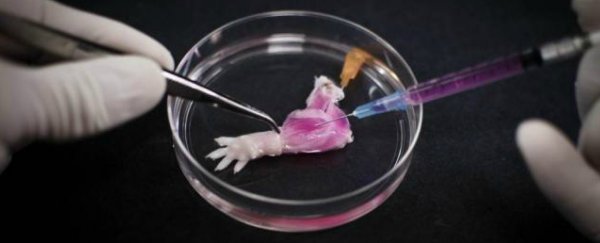Researchers from the Massachusetts General Hospital in the US have made a major breakthrough in the field of artificially grown body parts: the scientists have successfully grown a functioning rat limb using a technique that could eventually lead to fully natural replacements for human limbs.
Muscles and veins have previously been grown in laboratories, but up until now no one has repeated the trick with an entire limb because of the combination of different tissue types involved (muscles, bone, cartilage, tendons, blood vessels and so on). To solve the problem, scientists copied the technique already used for lab-grown organs.
To begin with, a donor limb from a deceased rat was stripped of all its cellular material, with only the primary vascular and nerve matrix retained to form the basis of the new limb. At the same time, vascular and muscle cells taken from a second rat were being carefully grown. Using a special bioreactor container, the dead limb was injected with these new vascular and muscle progenitor cells.
Through the use of a special nutrient solution and regular doses of electrical stimulation, the scientists were able to successfully grow the new limb to a working state. The vascular cells were found to be functioning normally while the muscles contracted at 80 percent of the strength of the muscles found in newborn animals.
"We have shown that we can maintain the matrix of all of these tissues in their natural relationships to each other, that we can culture the entire construct over prolonged periods of time, and that we can repopulate the vascular system and musculature," said Harald Ott MD, leader of the study, as CNET reports.
"Additional next steps will be replicating our success in muscle regeneration with human cells and expanding that to other tissue types, such as bone, cartilage and connective tissue," he added.
As you might expect, there's still a lot of progress to be made before the same ideas can be transferred to growing a human limb, but the findings published in the journal Biomaterials are encouraging. For Ott and his team, the next goal is to repeat the procedure with a baboon before work begins on working out exactly how a lab-grown limb could be attached to a body with no adverse side effects.
There are all kinds of potential complications in trying to graft a living, functioning limb onto someone's body - not least the reaction of the existing tissue - but as human hand transplants have proved, they're not necessarily insurmountable. If scientists can make the process work then natural limb transplants would offer many advantages over the robotic prosthetics in use at the moment - the ability to feel heat and pressure, for example, plus a more natural learning process for the brain as it adjusts to the new appendage.
